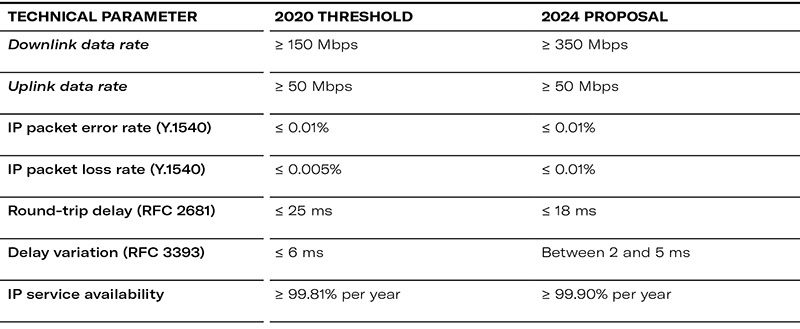- within Media, Telecoms, IT and Entertainment topic(s)
- within Law Department Performance, Litigation, Mediation & Arbitration and Insurance topic(s)
Introduction
BEREC1 has approved a proposal to amend the guidelines on the requirements that electronic communications networks must meet to be classified as very high capacity networks (VHCN2), in particular with regard to downlink and uplink bandwidth, resilience, latency and variations. This document was open for public consultation until 30 April, and the final version is expected to be published by 31 December 2025.
Article 82 of the European Electronic Communications Code (EECC) gives BEREC responsibility for developing guidelines on the criteria for classifying a network as having very high capacity. In this context, BEREC intends to (i) update these criteria in the light of the development and maturity of new technologies and (ii) provide practical information on the capacity of communications networks and operators in accordance with Article 4(1)(j)(i) of the BEREC Regulation3.
The new version of the guidelines focuses on the following issues:
- Review of the current performance of fixed networks and, based on this assessment, confirmation of the performance thresholds initially set for 2020.
- 5G technology, in particular as BEREC updates the performance thresholds for wireless networks based on data collected from mobile network operators on this technology.
Proposed changes to the guidelines
Four years after the first version of the guidelines, and following surveys on the state of the art of VHCN technology and performance in Member States4, BEREC considers that the guidelines should be updated.
According to the guidelines, networks that can be considered as VHCNs must meet the following performance thresholds:
- Consist entirely of fibre elements, at least to the distribution point (multi-dwelling).
- Provide wireless connectivity with fibre to the base station.
- Be capable of providing a fixed link under normal peak conditions with similar network performance in terms of downlink and uplink bandwidth, resilience, error-related parameters, latency and jitter, at least up to the distribution point (multi-dwelling).
- Be capable of providing wireless connectivity and, under normal peak conditions, offer network performance equivalent to that achievable by a network providing wireless connectivity with fibre to the base station.
The analysis, based on data collected in 2024, confirms technological stability in the fixed segment, with no relevant developments identified with respect to the most advanced access technologies already considered in 2020, namely G.fast (212 MHz) and DOCSIS 3.1. On the basis of this empirical evidence, BEREC concluded that the performance thresholds defined at that time should be maintained as they were still considered appropriate for the current state of the art.
Updating the thresholds applicable to mobile networks in the context of VHCN classification
The proposed update of the BEREC Guidelines includes a review of the technical criteria applicable to mobile networks for the purpose of qualification as Very High Capacity Networks under Article 82 of the EECC5. The aim of this review is to ensure that mobile networks, in particular those based on 5G technology, can be considered technically equivalent to the latest generation of fixed networks, provided that they meet objective performance thresholds under normal peak conditions.
BEREC's analysis is based on data collected from mobile network operators in 19 Member States between May and June 2022. The methodology used distinguishes between two scenarios6:
- Scenario 1: represents the current performance of commercial networks, reflecting actual conditions of service delivery to end-users.
- Scenario 2: refers to pilot deployments or technology configurations with the highest level of performance available, even if not widely commercialised.
BEREC notes that the data collection focused mainly on Scenario 17 , given the early stage of 5G technology deployment in many markets at the time of data collection. This methodological limitation required a cautious review based on empirical evidence representative of the current state of mobile infrastructure in the EU.
A comparison between the thresholds defined in the original version of the Guidelines (2020) and those now proposed shows the following adjustments:

It follows from the above that BEREC is proposing a cautious update that reflects developments in mobile network performance, in particular in terms of bandwidth, latency and availability indicators. The retention of some parameters (uplink) and the adjustment of others (packet loss) reflect a compromise between technical requirements and regulatory reality.
Regulatory implications and issues to be considered in response to the public consultation
The proposed update of the BEREC Guidelines has important implications for national regulatory authorities (NRAs), which are responsible under the EECC for applying the technical criteria in the context of the markets they supervise.
Although limited in scope, the new version of the Guidelines raises a number of issues that deserve particular attention in the public consultation, of which we highlight the following:
- The appropriateness and proportionality of the proposed thresholds: The increase of the downlink threshold to 350 Mbps should be considered in the light of the principle of proportionality, taking into account the asymmetries in coverage between urban and rural areas and the objectives of digital inclusion.
- Technical and operational definition of 'usual peak conditions': The lack of a harmonised definition makes it difficult to apply this criterion consistently, so it may be relevant to provide more detail on the measurement methodology and reference parameters to be taken into account when defining this concept.
- Coordination with the objectives of the EU Digital Decade: The revision of the Guidelines should be coordinated with the objectives of the Digital Decade 2030 programme, including regulatory predictability and the anticipation of multi-annual connectivity targets8.
The consideration of these aspects in the final version of the Guidelines could help to strengthen the legal certainty, regulatory consistency and technical feasibility of the Guidelines themselves, and ensure a consistent and effective application of the criteria for qualifying VHCNs in the European area.
Footnotes
1. Body of European Regulators for Electronic Communications.
2. Very High Capacity Networks.
3. Regulation (EU) 2018/1971 of the European Parliament and of the Council of 11 December 2018 establishing the Body of European Regulators for Electronic Communications (BEREC) and the Agency for Support for BEREC (BEREC Office).
4. In the first quarter of 2024, BEREC, with the support of Member States' national regulatory authorities, collected technical data from fixed network operators, including fibre-to-the-building (FTTB) networks terminated with copper pairs and hybrid fibre-coax (HFC) networks with fibre to the premises. The purpose of this data collection process was to assess the actual performance of the most advanced technologies currently in use and to verify the relevance of the thresholds set out in the 2020 Guidelines.
5. The EECC, in Article 2(2), defines a very high capacity network as a specific type of electronic communications network and not just as a segment of a network. In this respect, in order to assess the performance of equivalent networks, it is necessary to consider the network architecture up to the point of termination at the end-user.
6. The metrics considered to define these scenarios were: (i) normal peak conditions; (i) the service with the highest data rate (downlink+uplink) currently available on the network; (iii) other services available with the same quality of service (QoS) to the end-user; (iv) end-user QoS limitations caused by CPE/ME34 not taken into account.
7. See points 112 and 119.
8. According to Article 4(1)(2)(a) of Decision (EU) 2022/2481 of the European Parliament and of the Council of 14 December 2022 establishing the Digital Decade Policy Programme for 2030, by 2030 "all end users at a fixed location are covered by a gigabit network up to the network termination point, and all populated areas are covered by next-generation wireless high-speed networks with performance at least equivalent to that of 5G, in accordance with the principle of technological neutrality". According to recitals 13 and 14 of Decision (EU) 2022/2481, this objective aims at ensuring digital connectivity with the best performance, resilience, security and sustainability for everyone and everywhere in the Union, including in rural and remote areas. To this end, the Digital Decade 2030 programme states that all transport technologies and systems capable of contributing to the achievement of gigabit connectivity, including current and future advances in fibre, satellite, 5G or other future ecosystems and next generation Wi-Fi, should be treated equally where they offer equivalent network performance. In this respect, the alignment of the BEREC Guidelines with this strategic framework helps to ensure regulatory consistency and stability in the pursuit of these objectives.
The content of this article is intended to provide a general guide to the subject matter. Specialist advice should be sought about your specific circumstances.




